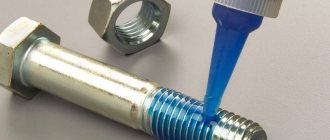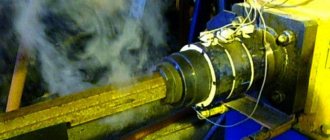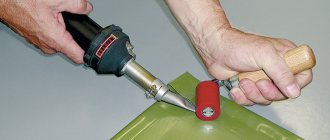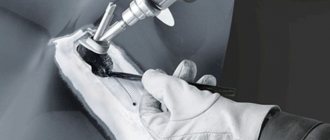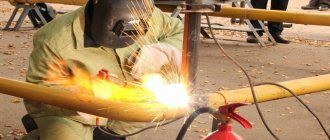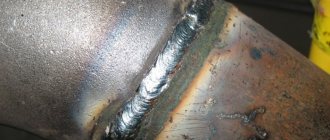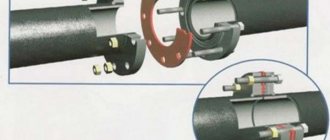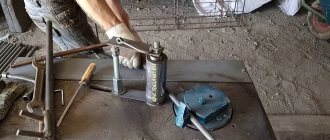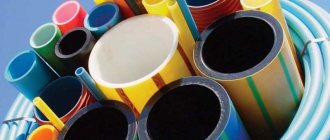Cold welding for heating pipes is an adhesive for eliminating leaks in a pipeline that does not have heavy loads, high pressure, or elevated temperatures. This type of heating system repair has nothing to do with inverter welding. Leaks are eliminated due to the high adhesion of the adhesive to the surface. After cold welding has set, the final result is not inferior in quality to a classic seam.
Application of the product does not require any specific skills, so repair work can be easily done with your own hands. This method is appropriate in situations where hot welding is dangerous or causes technical difficulties. It is suitable for spot sealing plumbing fixtures, radiators, pipes, expansion tanks and other structural elements of the heating system.
Advantages
- reliable elimination of cracks, chips and leaks in household pipelines;
- safe use, no deformation or stress on the metal;
- When forming a seam, no heating is allowed, no additional tools are needed;
- does not melt the material, suitable for repairing metal-plastic and plastic structures;
- repairs do not take much time, are suitable for sealing leaks in an emergency, you must strictly follow the manufacturer’s instructions;
- The most cost-effective way to repair water pipes.
Methods and means for repairing PVC pipelines
During pipeline operation or installation work, it is impossible to completely eliminate the possibility of leaks. In this case, you need to find a solution for urgent repair of products or restoration of tightness in connecting nodes. Let's consider which adhesive or sealant for polypropylene is suitable for such purposes.
Leakage in the hub connection with the fitting Source tumentoday.ru
Causes and consequences of leaks
Identifying root causes is often helpful in finding problems and solutions. More often this is a depressurization of the connecting seam. To prevent or minimize the risks of “gaps” appearing, you need to monitor:
- temperature conditions during the soldering process;
- degree of reliability of fixation of nut fasteners or crimp fittings;
- correct preparation of elements for soldering, welding or other connections (cut angle, evenness of edges, cleanliness of walls);
- the applicability of the adhesive for a specific section of the pipeline;
- admissibility of the use of sealing and sealing materials.
It is not difficult to identify problems in polymer pipelines in a timely manner. In places of depressurization, condensation (dew), leaks appear, or the pressure in the system changes downwards. Without urgent intervention, the situation may turn out to be an emergency. This applies not only to the water supply or sewerage system itself, but to neighboring premises, apartments, houses, furniture and interior items, household appliances, and electrical wiring.
Consequences of failure to detect a leak in a timely manner Source ytimg.com
Review of methods and materials for pipeline repair or restoration
The action algorithm includes three stages: turning off the water, troubleshooting, testing the system for serviceability. Only after this can you return to full operation of communications.
To stop the transportation of liquid, it is not always necessary to turn off the central riser in a particular house. Today, plumbers are trying to create separate circuits or bypasses by integrating shut-off valves or tap fittings into the system. This way, it will be possible to de-energize only part of the pipeline and continue to use the rest as before.
Before carrying out restoration measures, you need to decide how to seal the plastic water pipe. Here are the main criteria for choosing funds:
- efficiency;
- performance;
- ease of use.
More often, connections of polymer products are made with the creation of conditions for polymerization. In this case, it is impossible to disassemble the monolithic assembly and create it back. Therefore, it is necessary to cut out part of the contour and insert a new one using a similar technology (which was used previously).
Replacing a damaged section of a pipeline Source homify.com
Flaws
- used only for minor repairs of pipe damage in places where there is no load;
- requires careful adherence to application technology, otherwise it will not stick;
- during the welding process it is necessary to maintain the specified temperature;
- Unlike inverter welding, the seam is not durable, it is only a temporary measure.
Cold welding pipe repair
Review of properties and methods of fastening PVC pipes
Products made from unplasticized polyvinyl chloride are characterized by rigidity and high strength. Hollow materials with a round cross-section are also distinguished by their tightness, with a service life of over 50 years (reaches a century-long figure). For installation of communications, glue for polypropylene pipes is often used.
Brief technical description
PVC pipes are inert to corrosion, most chemicals and biological activity. Such properties are in demand in the construction of water supply and sewerage systems. Other characteristics are also useful here, such as:
- mechanical resistance to water hammer and pressure up to 1.6 MPa;
- maintaining quality at temperatures from -15 to +66 degrees Celsius (CPVC up to +100 degrees);
- resistance to environmental conditions (ultraviolet radiation, changes in humidity, temperature within acceptable limits);
- the smoothness of the walls determines low hydraulic resistance, absence of plaque and build-up from salts and fats (it is easy to clean the outside);
- safety for humans, animals and plants.
Plastic water supply in a residential area Source sakh.com
It is also worth noting the affordable prices and easy installation. The latter implies easy cutting, elasticity and a method of fastening individual elements. Here it is enough to have a set of inexpensive fittings and glue for PVC sewer or water pipes.
Product installation
The assembly of communication lines is carried out in three ways: using sockets, bolts or using related parts. In the first case, pipes for sewer systems are used. On one side they are made with a thickening, the inner diameter coincides with the outer diameter of the main part. That is, channels or corners with tees are simply inserted into each other. To ensure the tightness of the connections, the walls are additionally coated with glue for plastic pipes.
In the case of ventilation systems, gluing is not necessary; you can limit yourself to sealing agents. Another relevant connection here is a flange connection. The technique is applicable to large-diameter pipes (entry into the building, installation of valves, valves, taps).
Flange connection of polymer channels Source techfabinternational.com
The second technique applies to plumbing products of relatively small diameter. Fittings are additionally used here. These include connectors (at different angles), tees, adapters with different end diameters. Here, for installation, you may need not only glue, but a special iron for working with polymer pipes and a bevel remover. Due to the strong and tight connection (subject to the rules), the method is otherwise called chemical welding.
Types of adhesives
Cold welding is in demand for spot repairs of pipes. Glue from foreign and domestic brands is available for sale. It differs not only in cost, but also in quality. The following materials have proven themselves well:
- Abro and HI-Gear - imported;
- Almaz and Polymet are domestic.
The main element is epoxy resin, which gives the ingredients a uniform composition and plasticity. Mineral additives are used as additional components: iron oxide, sulfur and others that affect the quality of adhesion. Each manufacturer determines their name and quantity independently. A metal component is used to enhance strength after hardening.
Causes of defects in adhesive joints
The use of glue ensures durability and reliability of fastening of polypropylene pipes, but sometimes water leaks occur. The reasons are:
- Poor surface preparation, presence of significant irregularities;
- Presence of dirt and grease;
- Incomplete sizing of the seam, actions must be carried out quickly, otherwise a film may form on the glue, which will no longer allow obtaining a strong adhesion;
- Poor mixing of the solution, no bubbles are left;
- Low compression force of materials, violation of compression time;
- Inappropriate adhesive composition.
Glue for PVC pipes and fittings is an excellent option for joining them yourself. The method will help save your budget, but the solution must be chosen carefully. And the work is carried out in compliance with the rules.
Criteria for choosing pipes and type of glue
Cold welding for pipes varies in consistency and composition. Liquid glue is produced in two components - in the form of an adhesive mixture and a hardener. They are combined in a certain proportion immediately before use. When choosing a material for sealing defects, you need to take into account the composition and purpose. The plastic analogue has a consistency similar to plasticine. It is sold as a one-component or two-component mixture. It is made in the form of a bar, which is thoroughly kneaded before use. Manufacturers offer the following types of cold welding:
- for metal - suitable for temporarily sealing leaks in low-pressure metal pipelines, tanks, carburetors and car radiators;
- for plastic pipes - a specialized composition for plastic and plastic parts, eliminates cracks in the body well, suitable for PVC pipes, seals joints well;
- universal - can be used for plastic, metal, polypropylene, glass and ceramic products, glues worse compared to specialized compounds;
- for plumbing – eliminates cracks and leaks on sinks, toilets and other porcelain and earthenware plumbing fixtures.
Types of cold welding adhesives
Rules for working with adhesives
When working with glue, you should always read the manufacturer's recommendations. Many compounds cannot be left open for more than a few minutes, because... they set quickly, making their further use difficult. The average time during which the glue can remain open is 4-5 minutes.
In summer and winter, the compositions harden the fastest: at high ambient temperatures, the glue may become unusable after 1-2 minutes, and at low temperatures, the viscosity increases. Therefore, you should pay attention to the manufacturer’s instructions regarding operating temperature conditions.
When purchasing a specific brand of glue, you should pay attention to its preparation for use. Some types are easy enough to mix, but two-component compositions have to be combined correctly and their consistency must be monitored.
There is a risk of incorrect mixing, which leads to loss or change in adhesive properties.
You should pay attention to the solvent for degreasing surfaces. It is best to choose a composition from the same company as the glue. Even if the packaging of the adhesive composition states that degreasing is not necessary, it still makes sense to wipe the surfaces to be glued with a high-quality solvent.
Color and viscosity matter. Experienced plumbers prefer compositions of medium viscosity. They are easy to apply, and when joining parts, such glue does not spread, so you do not have to remove it with napkins.
As for color, the colorless composition is suitable for white and colored pipes. It is not visible, even if the drops protrude beyond the glued area and freeze.
Using Cold Welding to Repair a Leaking Pipe
Before starting welding work, it is necessary to turn off the shut-off valves, drain the water, and ensure good access to the problem area. The area with cracks and chips is cleaned of dirt and degreased. Be sure to remove old layers of paint. Old paint at the leak site can be cleaned with coarse sandpaper or a grinder using special attachments.
If repair work is carried out during the heating season, it is not always possible to drain the water from the system. Defects are repaired on a functioning main line. In this case, you should not count on high-quality adhesion between materials. The flowing liquid does not allow the glue to adhere well to the area.
Step-by-step instructions for using the composition
Before you start gluing plastic pipes, you should make sure that there is normal air circulation in the room and the temperature is between 5-35°C.
In addition to materials, the work will require some tools:
- for marking - marker and measuring tools;
- for cutting pipes - pipe cutters, jigsaw or hacksaw;
- for cleaning surfaces - sandpaper;
- for degreasing – solvent;
- to apply the composition - the glue itself, a brush made of natural bristles (some glues, including Tangit, are immediately equipped with a suitable brush) or a glue gun.
Surface preparation is an extremely important stage in gluing parts. They should be perfectly smooth and fat-free. If contaminants remain on the pipe, the glue will only stick on top of them and form a film, but there will be poor contact with the surface itself. This may cause leaks to develop over time.
PVC pipes are prepared for upcoming gluing in several steps:
Image gallery
Photo from
Step 1: Purchase socket fittings
Step 2: Fitting and marking pipes
Step 3: Marking pipes for preparation
Step 4: Cold Welding Rules
Pipeline bonding technology:
- Pipe marking . Before starting the installation of the pipeline, a design and detailed diagram must be prepared. The pipes are measured and marked using them.
- Cutting pipes . The next stage is preparing sections of the required length. It is best to use pipe cutters, but other tools will work. The main thing is that the cutting areas are level. The edges are cleaned with sandpaper.
- Bonding system elements . The most convenient way is a glue gun. With its help, you can evenly and accurately distribute the composition over the surface. If you don't have a gun, you should use a brush. The glue is applied so that in the selected area there are no areas free from it.
- Connecting parts . To connect, the system elements are pressed against each other for at least 20-30 seconds. During this time, the composition thickens and becomes more viscous. Then the part can be put aside for a day. It is important that the compression force is sufficient, otherwise the joint may leak during operation.
- Pipe cleaning . No matter how carefully the glue is applied, it may extend beyond the intended area. It is removed immediately before it hardens. A damp cloth, rag or sponge is suitable for this.
- Polymerization of the composition . It takes 20-24 hours for the glue to harden, so it is better not to touch the system before. You cannot move, separate or reconnect parts, or run water through pipes.
When the glue polymerization process is complete, you should check the efficiency of the system. It is launched in operating mode and all joints are carefully examined.
If it doesn't leak anywhere, everything is fine. If leaks are detected, the connections are additionally sealed.
Image gallery
Photo from
Stage 1 – straight cutting of the pipe
Stage 2 - chamfering the pipe
Stage 3 - applying adhesive composition
Stage 4 – process of gluing parts
An important nuance: when gluing parts you need to work extremely clearly. The pipeline section is inserted into the fitting in one motion. It should not be sharp, but fast. When the pipe is inserted, it should not be wiggled or twisted so as not to reduce the strength of the connection.
Is it possible to repair a heating battery using cold welding?
For metal heating circuits, specialized glue is purchased that allows repair and operation of the pipeline at high temperatures. Cold welding for steel radiators allows you to eliminate fistulas in hot water supply circuits. This method of sealing defects is used temporarily. At the first opportunity, it is recommended to weld this fragment using an inverter.
Repair of heating batteries by cold welding
This method is not recommended for use on complex structural elements of heating and water mains. Using an adhesive composition, only surface repairs of cast iron, steel and aluminum pipelines, radiators, and expansion tanks are performed, provided that there is free access to the defect site. The adhesive mixture is not a complete weld. It eliminates the defect by sealing the crack, so that mechanical action disrupts adhesion. The connection is not “pull-off” stable.
How to Seal a Hole with Sealing Tape
Using this modern material, you can efficiently eliminate small leaks in pipes located in bathrooms. Externally, it is an adhesive fabric impregnated with special substances. Most often, joints and connecting elements are sealed with sealing tape. As for straight sections, they can also be repaired using this method.
READ ALSO: How to fix a leak in a plastic pipe: how to fix it if the joint is leaking, leaking at the junction of polypropylene pipes because they burst
When using sealing tape, it is important to follow the following sequence of work:
- The damaged area must be thoroughly cleaned and dried.
- After stretching a small piece of tape, it is wrapped around the pipe. It is important that this procedure is accompanied by constant tension in the tape, otherwise folds will appear.
- When winding, each new turn should be laid on half of the previous one. It is best to pack the pipe with two layers of sealing tape.
The main disadvantage of this method is the insufficient resistance of the repair material to sunlight. To achieve a good service life, the wound tape is coated with additional protection.
Description and distinctive features
Liquid welding for plastic is a polymer adhesive mixture for joining parts of the same and different structures. The main distinguishing feature of this repair technique is that there is no need to subject the material to heat or melting.
The plastic sticks together thanks to the components contained in the adhesive. After the mass dries, the connection is close in reliability to the material that was restored.
The components of cold welding on plastic are:
- additives (mineral);
- epoxy and amine resins;
- a piece of metal.
This glue can be used not only in cases where plastic repair is required. It can also be used to restore the surface of materials such as wood, metal alloys, etc.
Adhesives can be universal. In this case, they can be used for gluing various materials. However, they form a less reliable connection than specialized compounds for a specific surface.
Methods of use
To repair pipes, you need to prepare everything you need - the welding agent itself, acetone or alcohol, sandpaper, rags and clamps. The method of sealing radiators varies somewhat depending on the type of welding - liquid or plastic. It is important to choose a suitable product that is suitable for pipes under pressure (metal or polypropylene). Next, you need to prepare and mix the material, and you should work faster with liquid products.
Welding application methods:
- simply sealing the defect with a piece of mass, flattened and kneaded with your fingers,
- the use of special fiberglass fabrics, threads for wetting with epoxy, followed by wrapping with rubber, wire or without it,
- gluing onto a large defect covered with a metal patch.
If the leak is strong, you can make the composition even more durable with your own hands. You need to take any aluminum or bronze part, grind it a little over paper, obtaining metal powder. It needs to be added to the epoxy mixture, which is then used to saturate the turns of thread or fabric.
PVC products and their technical characteristics
PVC (short for polyvinyl chloride) is a polymer. Perhaps its main advantage is its environmental friendliness. However, its melting point is quite low. Moreover, this material is sensitive to low temperatures. However, these two disadvantages are more than compensated for by the high strength and durability of the material.
Application area
Plastic refers to synthetic polymer materials .
It is widely used in various industries, science, and everyday life. The wider the scope of application of polymers, the greater the demand for methods of its repair. Currently, cold welding for plastic is successfully used to repair the following materials:
- plastic piping and plumbing;
- internal and external plastic of the car: bumpers, door cards;
- housing and parts of household appliances;
- plastic products;
- linoleum and other flooring.
- fishing gear.
Suitable brands
Adhesive for plastic takes up a significant part of production, since in this segment the requirements for the composition are not as strict as, for example, for means for joining metals. There is a wide selection of products from both domestic and foreign manufacturers on sale. Let's look at the most popular products in the mid-price segment:
- Hi-Gear Super putty for plastic HG6505 . Country of origin: USA. A universal product for joining products made of plastic, glass, PVC, ceramics, and metal. It has high water resistance parameters. Not soluble in petroleum products. Complete polymerization time is 1 hour. Maximum operating temperature – +204 degrees Cº. Tensile strength – 500 kg/cm².
- DoneDeal DD6659 Super adhesive for plastic . Another American made product. Indications for use: plastic, polypropylene, polyvinyl chloride, glass, plexiglass and other polymers. Complete polymerization time is 24 hours. Heat resistance ranging from -50 to +94 degrees Cº. Tensile strength – 204 kg/cm².
- Mannol 9827 . Product made in Lithuania. One-component adhesive for universal use. High polymerization speed – 15 minutes. Operating temperature range – from -10 to +80 degrees Cº.
- Cold welding Universal LAVR Ln1721 . Product from a Russian manufacturer. It is a high-temperature and water-resistant two-component adhesive with universal properties. Can be used on wet or oily surfaces. Ultimate strength is achieved after 2.5 hours. Operating temperature from -60 to +150 degrees Cº.
- Adhesive cold welding for plastic “ASTROhim” AC-9321 . Russian product. According to its technical characteristics, it is an analogue of the previous product. The manufacturer recommends for use in the automotive industry. For example, weld a hole in the expansion tank of the cooling system.
Important! Buy cold welding from trusted manufacturers. Beware of low-quality products of questionable manufacture. Pay special attention to the expiration date of the product.
Welding technology for polypropylene pipes, expert advice
Polypropylene pipes differ from traditional metal pipes in their affordable cost and ease of installation. You can install such communications yourself, the main thing is to master the technology of welding polypropylene pipes, understand the specifics of working with the material, and strictly follow the instructions and recommendations of specialists in this field.
General information on welding polypropylene pipes
Today, there is a widespread replacement of old metal pipes with modern polypropylene pipes, which are made of a special type of plastic - rond-copolymer.
Polypropylene pipes are used for arranging various communications (cold pipelines, hot water transportation, heating systems). The pipes differ from each other in wall thickness (PN10, PN16, PN 20) and the presence of stabilized aluminum foil (PN20Al).
The pipeline installation procedure allows you to connect pipes to each other without additional components (adapters, tees, fittings or angles), but using various welding methods. The developed technology for welding polypropylene pipes covers the soldering of pipelines of various diameters and all types of connections: welded sections, turns, contours, fastening and shut-off valves.
When working with polypropylene communications, it is important to remember that dismantling the system is impossible.
A welded or soldered joint cannot be separated. Therefore, when welding plastic pipes, you must act carefully, without haste, following the developed sketch of the future heating or water supply system
One of the conditions for obtaining a strong and high-quality weld is that the pipe sections being connected must be made of polymers of the same chemical composition. Therefore, it is better to choose pipes of the same brand, and the color does not matter.
Welding of polypropylene pipes can be carried out end-to-end and in socket. The first method of soldering pipes is carried out without the use of fittings.
The second method is more reliable, but is more often used to connect small cross-section pipes or when it is necessary to change the direction of the pipeline. In this case, connecting elements made of the same polymer as the pipes are used. When soldering, the parts being connected melt—the outer part of the pipe and the inner surface of the fitting.
Technology of polyfusion welding of polypropylene pipes
necessary tools and equipment
In order to correctly connect polypropylene pipes, you need to prepare a detailed diagram of the future pipeline, mark all turns, the location of shut-off valves and prepare the necessary tools.
For polyfusion welding you will need:
- machine for welding polypropylene pipes;
- nozzles for welding machine;
- contact thermometer;
- pipe cutter or nippers;
- shaver;
- chamfer;
- meter;
- marker;
- non-synthetic fabric;
- alcohol.
A welding machine, or as it is popularly called, a soldering iron for welding polypropylene pipes, consists of a heating plate, a thermostat and a holder. The heating plate has two holes for attaching soldering elements.
The soldering iron kit usually includes nozzles for welding polypropylene pipes with a diameter of 20, 25, 30 and 40 mm. They are sufficient to connect any domestic pipelines. Iron nozzles are coated with Teflon - this prevents the melted plastic from sticking to the surface of the nozzle.
Sometimes the welding machine kit also includes a pipe cutter, which provides an almost perfect cut accurately and quickly.
The recommendations and procedure for working with the welding machine, set out in the instructions for the equipment, must be strictly followed in order to avoid damage to the pipes and the occurrence of an emergency situation on the pipeline
Some experts prefer to use cutters that can handle cutting various types of polypropylene pipes, including those reinforced with fiberglass or aluminum.
To weld reinforced polypropylene pipes, you will need a shaver, which is used to clean the edges of the pipes before soldering.
A bevel remover is necessary when the pipe is difficult to install into the coupling. The device chamfers an edge at an angle of 60 degrees, the cutting width is up to 40 mm.
preparatory stage of welding
Do-it-yourself welding of propylene pipes begins with preparing the tool for work:
- Attach nozzles of the required size to the welding machine;
- set the temperature of the soldering iron and plug it into the electrical network (heating time will largely depend on the air temperature);
- before work, the Teflon surface of the nozzles must be wiped with a non-synthetic cloth;
- the heating temperature of the welding machine can be controlled using a contact thermometer;
- The functionality of the cutter or pipe cutter must be checked on a prototype pipe - the cut must be without depressions, otherwise the tool must be sharpened.
The connection pipes must be prepared for welding as follows:
- inspect the walls of the parts, fittings must be in working order;
- welding fittings and pipes must be cleaned and degreased (wipe with alcohol);
- the fittings must fit tightly on the frame;
- measure and cut the pipe to the required size;
- it is better to bevel the end of the pipe prepared for welding at an angle of 30-45 degrees (especially important for pipes with a diameter of more than 40 mm) - when the pipe is inserted into the fitting, the material will not tear up;
- The oxidized layer must be removed along the entire length of the connection;
- in reinforced pipes at the ends of the connection it is necessary to remove the aluminum layer using a shaver;
- on pipes reinforced with fiberglass, such cleaning is not necessary;
- Pre-insert the pipe into the fitting and mark the entry depth with a marker; the pipe should not be seated in the fitting coupling all the way (a gap of 1 mm is left) so that the cross-section of the pipe does not narrow during soldering.
welding sequence of polypropylene pipes
- Let's start welding polypropylene pipes. The instructions provide for the following actions:
- Immediately before connecting the pipes, degrease them again.
- First put the fitting part on the nozzle of a heated soldering iron, and then the pipe.
- During heating, parts should not be rotated to prevent them from becoming deformed.
- Wait for the required time for welding polypropylene pipes. The interval depends on the power of the device and the size of the pipe.
- Remove the melted parts from the nozzles and connect them together using uniform, smooth pressure without axial rotation.
- Hold the fresh seam until partially cooled for 30 seconds.
welding algorithm for welded sections
If the pipeline has already been installed and there is a need to branch it, then it is not necessary to deform the system and disassemble a section of pipes; it is enough to weld the saddle correctly.
The installation procedure for the welded section is as follows:
- Mark the location of the future branch and drill a hole in it (use a special drill for plastic pipes).
- Clean, if necessary, scrape out the aluminum and degrease the hole.
- Install a nozzle of the required size on the welding machine and heat the tool to 260 degrees.
- Holding the device by the handle, install the heated nozzle into the hole.
- The heating fitting of the cooking seat must be inserted into the heating sleeve (all the way) and the heating time must be maintained (about 30 seconds).
- Remove the welding machine from the pipe and very quickly connect the welding seat to the melted hole.
- The saddle must be pressed tightly, aligning the axes, without rotating or loosening. It should take about 15 seconds for soldering, and 10 minutes for complete cooling.
After installing the saddle, you can further install polypropylene pipes and additional connecting elements into it.
possible errors when welding pipes
Mistakes made during soldering of a polypropylene pipeline lead to various problems: seepage and flow of water at the connection site, rupture of pipes, poor water pressure and other problems.
Typical errors in welding polypropylene pipes include:
- the gap is too large (more than 1 mm) between the edge of the fitting and the pipe (the connection section is thin and subsequently this is where a pipeline rupture may occur);
- excessive compression of two parts being soldered (a build-up is formed inside the pipeline, which reduces the water pressure);
- if the parts being connected are overheated, the tightness of the joint deteriorates, and if the parts are underheated, it will not be possible to solder the pipes;
- mismatch of the axes of the connecting elements will lead to deformation of the pipeline and loss of tightness at the joint areas.
Cold welding of polypropylene pipes
The cold welding method involves gluing pipe sections with a special glue that firmly connects various plastic-based synthetic materials, including polypropylene.
Cold welding of polypropylene pipes can only be used when installing a “cold” pipeline, since when it comes into contact with hot water, the glue loses its functions and the joint loses its strength
The procedure for welding polypropylene pipes using the “cold” method:
- Mark the pipeline joints on the pipes where welding will take place.
- Cut the pipes into sections of the required size.
- Apply Cold Welding glue to both cuts and press the edges tightly together, holding for 15 seconds.
- Secure the pipeline system so that the pipes are stationary.
- An hour after gluing, you can run water.
When working with Cold Welding, it is important to adhere to safety precautions with aggressive substances.
Welding polypropylene pipes with electrofitting
Electric-welded fittings (electrofittings) are fittings equipped with embedded wire heating elements, which melt at high temperatures and form a strong and reliable connection with plastic pipes.
Electrical fittings form joints that guarantee the tightness of the pipeline and protection from leaks and breaks.
To carry out welding using an electrofitting, you will need the same tools as for polyfusion welding.
Technology for soldering polypropylene pipes with an electric welded fitting:
- Use scissors to cut the pipes.
- Degrease the top of the pipe and the inner surface of the electrical fitting.
- Mark the insertion depth of the electrical fitting on the pipe.
- Clean the reinforced pipe from aluminum for the length of the connection with the fitting.
- Insert the pipe into the fitting and securely fix it, since when heated, the polypropylene will increase and under pressure can jump out of the fitting.
- Connect the electric welding machine to the network and wait for it to heat up.
- Connect the welding machine to the fitting using contact wires.
- Press the “START” button. The shutdown will happen automatically.
- After welding, cooling of the joint should occur naturally and without any mechanical loads (pressure, rotation, compression).
As you can see, when welding polypropylene pipes, a number of important points should be taken into account in order to avoid mistakes and get a strong and reliable pipeline that will serve without interruption for decades.
Author: Sergey and Svetlana Khudentsov
strgid.ru
Safety at work
Regardless of the composition: waterproof or high temperature, liquid or plasticine, etc., safety precautions must always be observed.
In order not to harm your health and get a reliable connection, it is important to know and not violate the following points:
- After drying, heat the mixture near the battery for about half an hour.
- Protect the skin from contact with adhesive. For these purposes, manipulations should be carried out in special clothing and seals. If the adhesive does end up on the skin, it is immediately washed off with water. If an allergic reaction occurs or something bothers you, you should definitely seek advice and treatment from a doctor.
- You should not use glue in cases where repairs are necessary to cutlery or those items that interact with drinking water or human food.
- Wear a respirator to avoid damaging the respiratory tract. Also, all manipulations should not take place in a stuffy room.
- Do not leave the adhesive or the part being repaired under direct sunlight.
In most cases, the seam is heat-resistant and does not emit a toxic odor, so the product can be used for household use.
Radiator repair
The technology for working with radiators is similar to that used when repairing pipes. The surface is also prepared - cleaned, washed, degreased.
Knead the required amount of welding (usually a ball about 20 mm in diameter) until a uniform color is obtained and the temperature of the material rises, and then press and smooth it on the damaged area, fixing it with a clamp or rag.
The water must be turned off in advance. Fistulas in radiators are eliminated using fiberglass - it is wrapped around the damaged area and the patch is impregnated with a liquid adhesive.
The composition usually polymerizes in a period of 30 to 40 minutes, but it is worth waiting a day before using the repaired battery again.
The cold welding method will help gain time until the end of the heating season in case of leaks and create reliable temporary seams simply and quickly.

